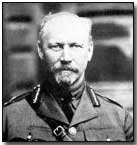Who's Who - Jan Christian Smuts
 Jan Christian Smuts (1870-1950) holds
the unique distinction of being the only individual to sign both peace
settlements reached after the First and Second World Wars. Of
Afrikaner roots (Smuts was born on 24 May 1870 in Malmesbury, Cape Colony),
Smuts fought in the Second Boer War of 1899-1902 against the British.
Jan Christian Smuts (1870-1950) holds
the unique distinction of being the only individual to sign both peace
settlements reached after the First and Second World Wars. Of
Afrikaner roots (Smuts was born on 24 May 1870 in Malmesbury, Cape Colony),
Smuts fought in the Second Boer War of 1899-1902 against the British.
Notwithstanding this, Smuts' argued for South Africa's place within the British Empire and worked with the British through both world wars, occupying senior positions in each.
British-educated at Christ's College, Cambridge until 1895, Smuts studied as a lawyer and took up an appointment as state attorney of Johannesburg, but served his adult life in political and military spheres.
During the Boer War he served as a commander in the field, demonstrating a particular talent for guerrilla warfare, whilst placing his legalistic training (together with a natural talent for negotiation) to good use at the conclusion of the conflict.
It was during the Boer War that Smuts became acquainted with Louis Botha, forming a close friendship that lasted until the latter's death in 1919. Smuts took a number of posts within Botha's cabinet prior to the outbreak of war in August 1914.
In the years preceding the First World War Smuts continued to argue the benefits of South Africa's place within the wider British Imperial strategy.
With the declaration of war, and with Botha - by now Prime Minister of the Union of South Africa - offering immediate military assistance to Britain, Smuts founded the South African Defence Force, which he ruthlessly used to suppress striking miners on the Rand. He also worked with Botha to put down civil rebellion against the decision to ally with Britain by a section of the Afrikaner population.
Botha handed over day to day military command of the invasion of German Southwest Africa (Namibia) in July 1915 to Smuts. Curiously, despite the German guerrilla leader von Lettow-Vorbeck's success in continually evading Smuts, his success in capturing large tracts of land, and especially the German East African capital of Dar-es-Salaam, brought Smuts great credit in Britain.
Arriving in Britain in March 1917 as head of the South African delegation to the Imperial War Conference, Smuts was feted by an admiring Lloyd George, who offered him a place in the War Cabinet.
Despite Lloyd George's reputation as an ardent 'Easterner', Smuts continued in his belief that the primary theatre of war should remain the Western Front (led by Douglas Haig), although he backed Lloyd George's view that a major campaign be initiated in Palestine (although Smuts declined Lloyd George's offer to lead it).
The following year, in 1918, Smuts played a notable role in the creation of the Royal Air Force (formerly the Royal Flying Corps, but now an independent section of the armed forces in its own right).
At the Paris Peace Conference, representing South Africa, Smuts, like Botha, argued for reconciliation with the defeated Germany, although he did agree the case for German reparations.
A major proponent of the League of Nations (and so, despite his reservations about growing U.S. worldwide influence, an ally of President Wilson), Smuts argued that Germany's overseas possessions - removed from her by the Treaty of Versailles - should be managed by League of Nations' 'mandates'.
With Botha's death in 1919 Smuts became Prime Minister of the South African Union until 1924, as he later did again from 1939-1948 (having served as deputy prime minister from 1933), playing an influential role in Winston Churchill's wartime government (also a colleague during the earlier First World War).
Churchill, who admired "his old friend", arranged for Smuts to be made an honorary Field Marshal in the British Army in September 1941.
Following the Second World War Smuts played a role in the establishment of the United Nations. Smuts lost the 1948 South African general election, dying two years later on 11 September 1950. The election of 1948 signalled the start of South Africa's slide into apartheid.
An Armlet was a cloth band worn around the arm to identify a particular duty or function.
- Did you know?
